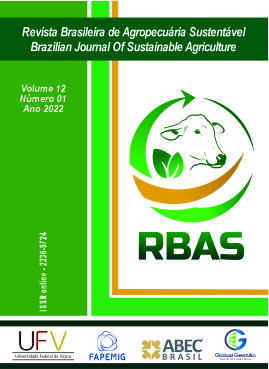ACCUMULATION OF DRY MATTER AND NUTRIENTS AS A RESULT OF NITROGEN FERTILIZATION IN BRACHIARIA BRIZANTHA (Urochloa brizantha)
DOI:
https://doi.org/10.21206/rbas.v12i1.13125Keywords:
dairy farming, forage, mineral nutrition, silage.Abstract
In Brazil, pastures are the main source of nutrients for ruminants, but most production systems are extensive, where there is low use of inputs to improve soil fertility. In the present work, the effect of nitrogen doses on the accumulation, dry matter partition and total crude protein content, in the leaves and stems of the Brachiaria brizantha cv. Marandu, was evaluated. The soil received dolomitic limestone and plaster in order to increase the base saturation to 60% in the 0 to 20 cm layer and to decrease the exchangeable aluminum in the subsurface layer. The experimental design was a randomized block, with four replications, with plots consisting of five meters in length and five meters in width. The nitrogen doses used were: zero (control), 50, 100, 150, 200 and 250 of N ha-1, applied to the soil surface, at the beginning of regrowth. The Brachiaria also received phosphate and potassium fertilizer in an amount equivalent to 50 kg of P and 150 kg of potassium per hectare. The Brachiaria was cut at thirty-seven days after fertilization. The evaluations were carried out on the central 9.0 m2 of the plot. There was a positive effect of nitrogen fertilization on all variables analyzed, even at the highest dose: 250 kg of N per hectare. For the accumulation of natural and dry matter in the aerial part of Brachiaria brizantha the effect was linear. The accumulation of dry matter in the aerial part was 4.46 t per hectare in the control treatment, rising to 6.03 t in the maximum nitrogen dose. The nitrogen doses influenced positively the percentage accumulation of dry matter in the leaves of Brachiaria brizantha, obtaining the equation Y = 25.529 + 0.0372 x, consequently there was a percentage reduction in the dry matter allocated in the rest of the aerial part of the plant. At the maximum nitrogen dose, the percentage increase in dry matter in the leaves was 17%. There was also an effect of nitrogen fertilization on the total crude protein content, in leaves and stems in all aerial part of the Brachiaria. At the maximum nitrogen dose, there was an increase of 86.78 g of crude protein per kg of dry matter, since in the control treatment the content was 67.5 g kg-1, rising to 154.3 g kg-1 at a dose of 250 kg of N per hectare. In addition to increasing the accumulation of dry matter and improving the bromatological quality of the forage, nitrogen fertilization also increased the production of protein, since at the dose of 250 kg of N per hectare the increase in the accumulation of protein was about 700 kg per hectare, compared to the control.
Downloads
Downloads
Published
How to Cite
Issue
Section
License
Copyright (c) 2022 Brazilian Journal of Sustainable Agriculture

This work is licensed under a Creative Commons Attribution-NonCommercial-NoDerivatives 4.0 International License.
1. Proposta de Política para Periódicos de Acesso Livre
Autores que publicam nesta revista concordam com os seguintes termos:
Autores mantém os direitos autorais e concedem à revista o direito de primeira publicação, com o trabalho simultaneamente licenciado sob a Licença Creative Commons Attribution que permite o compartilhamento do trabalho com reconhecimento da autoria e publicação inicial nesta revista.











